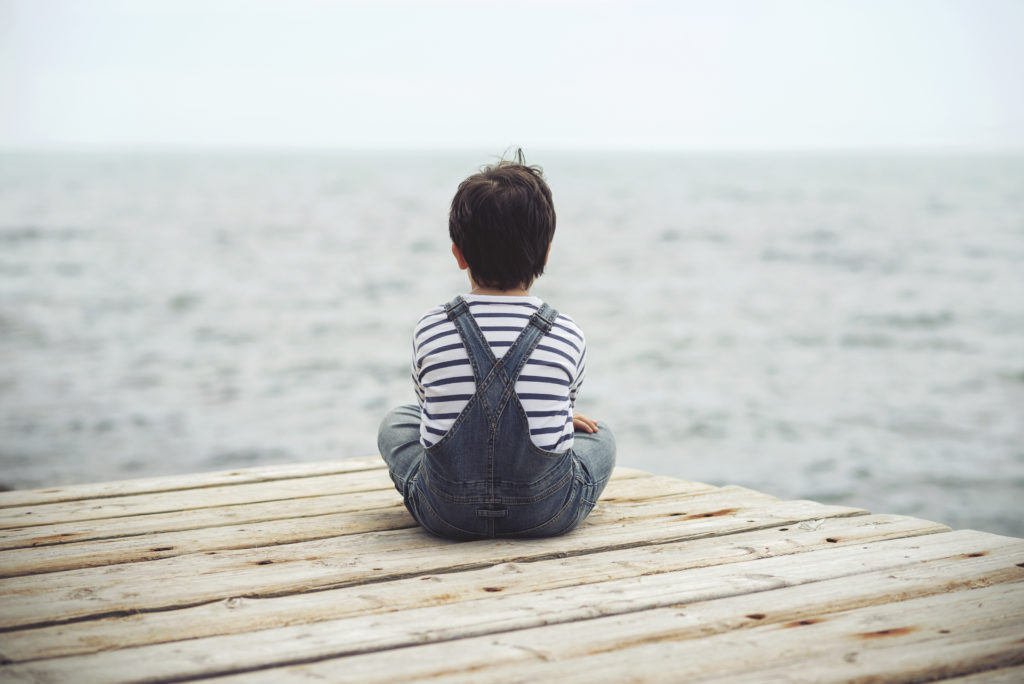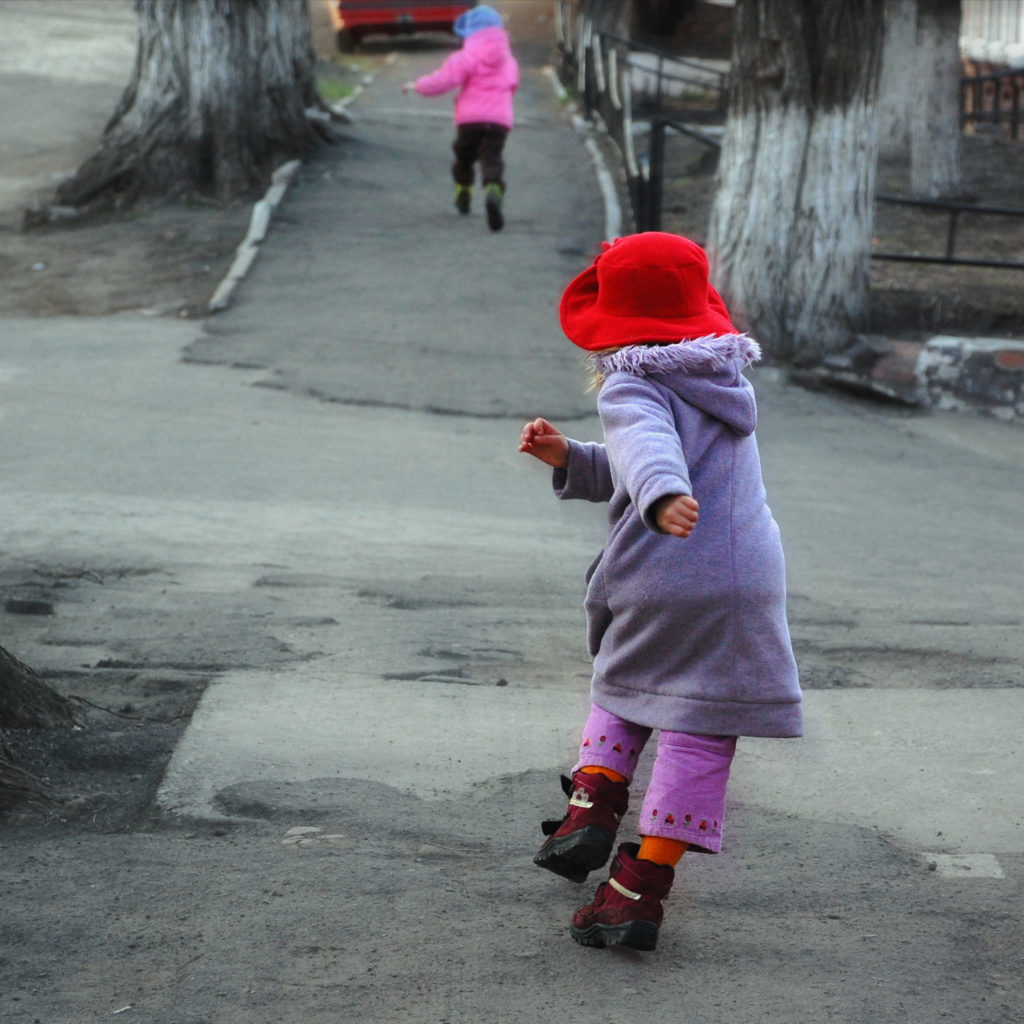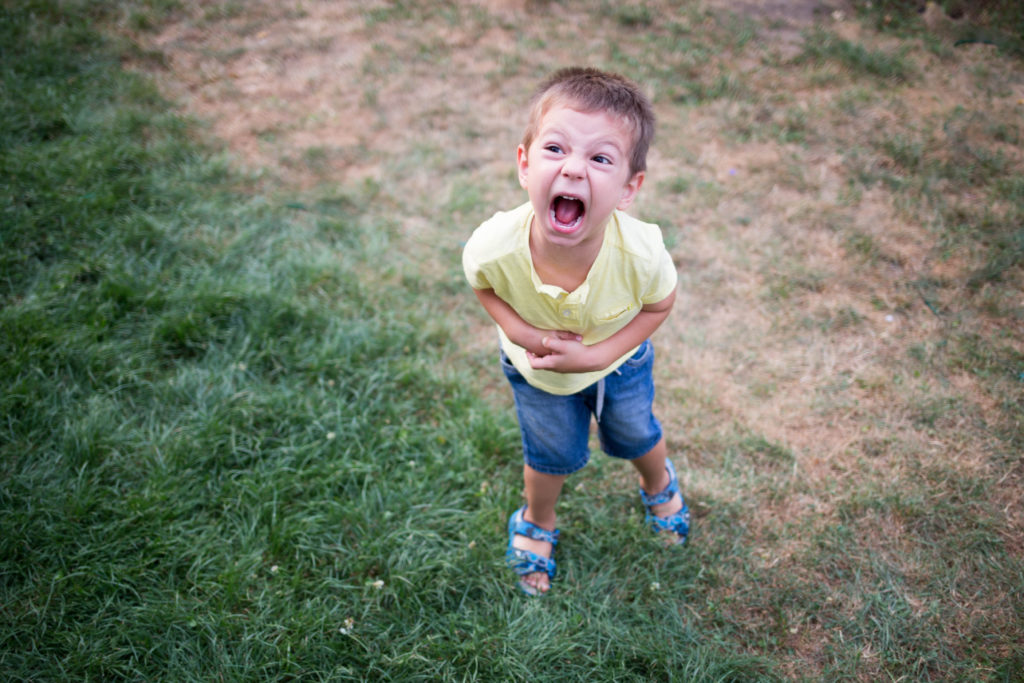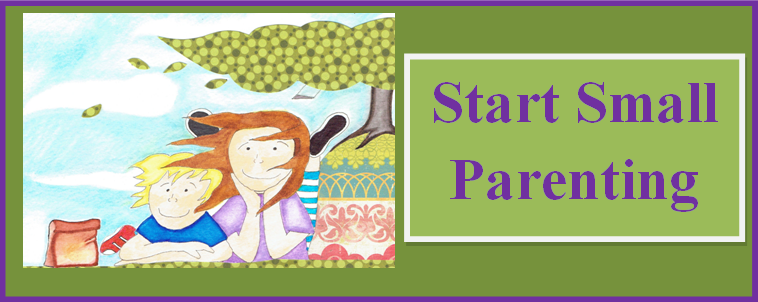
What is Self-Regulation?
Self-Regulation is the ability to have conscious control over impulses. This is a function of the executive center of the brain – or the neocortex – an area that develops later in small children than some other parts of the brain.
Development of Self-Regulation
There are three main factors that influence the development of the ability to self-regulate: biology and temperament, developmental stages, parental knowledge/guidance toward behavior education.
Biology and Temperament
Certain characteristics such as mood intensity and attention span are instinctive rather than a result of parenting. How does your child react in difficult situations? Observe and notice how certain stimulation affects your child’s ability to self-direct and maintain control.
Some executive functioning skills like the ability to plan and problem solve are also inborn. If a child struggles with attention deficit hyperactivity disorder (ADHD), for example, it may be more of a challenge to control her own impulses.
Developmental Stages
Infants and toddlers have limited access to the functions of the neocortex, so impulse control will often be difficult. The age and developmental stage of your child plays a part in Self-Regulation:
Birth-1: Infants can regulate some aspects of their environment by turning away from unpleasant stimuli like noise or light. Observe any ability your baby has to calm herself. This is the start of impulse control.
Toddlers: In this stage, there is a drive for independence and accompanying frustration at lack of competence. When your child acts out (e.g., hitting or biting) there may be a clash of these unbalanced forces. She might know her action goes against what’s expected in the family, but she does not have the control to stop it. She may not try to stop because she has an innate sense of curiosity as to the reaction of another child or parent. She also may be trying to discern the rules of the household and if parents mean what they say.
Ages 3-4: Preschoolers are discovering the power of language to assert their needs and desires despite sometimes overwhelming emotions. The added complications of social expectations can stress the executive learning centers, making it difficult to carry out the actual desired behavior or have self-control in the situation.
Ages 5-6: At this age, children are primed to learn more self-control through physical games and experiences. This is the opposite of many school experiences where impulse control is expected to be learned while a child sits and focuses for long periods of time.
Ages 7-8: Highly imaginative play capabilities at this age provide a perfect forum to build concentration and self-regulated rule structures. Children can learn to soothe themselves, make use of Pressure Release Valves to release the day’s stress, and try suggested self-control strategies.
Ages 9 and up: At this point, children are honing distinct interests and personalities. They are able to set and achieve goals which continue to build self-control and use executive function skills.
Parental Knowledge/Guidance Toward Behavior Education
Many parents use Outer-Regulation to try to change a child’s off-track behaviors. This includes the following adult behaviors: ask, plead, beg, move the child’s body, threaten, coerce, punish, yell, guilt, shame, reason, or separate the child from the parent.

There are times and developmental stages where a parent must use Outer-Regulation to keep their child safe. Child runs towards the busy street? The parent must run after the child and take her hand or pick her up to keep her safe. One sibling is about to hit another with a heavy book? The parent can stop the child’s arm before the action is completed.
Parents often help children with skills before they are actually able to do them. Take the example of learning to walk. Parents hold their children’s hands above their heads while the child takes steps around the room. They do this over and over, helping the child practice, until the child is ready to let go.
The same with helping the child develop Inner-Regulation – or Self-Regulation. Parents can help kids learn new skills to improve their Self-regulation as they grow. The process starts with learning the skill until it can become a conscious choice, later followed by an internalization of the behavior.
The Marshmallow Experiment
In his books, Emotional Intelligence and Working with Emotional Intelligence, Daniel Goleman refers to the Marshmallow Experiment, which demonstrates the significance that controlling impulses can have in a lifetime.
The experiment took place in the 1960’s. A group of four-year-old children from the Stanford University pre-school were offered one marshmallow to eat immediately or two marshmallows if they could wait until the experimenter returned.
Some children couldn’t resist. They impulsively ate the marshmallow. Others were able to wait 15-20 minutes and were given two marshmallows.
Here’s where it gets interesting. The children were followed up as young adults. There were clear differences between the two groups.
The children that waited for the second marshmallow were shown to be more attentive as adults, more intellectually skilled, and more responsible and reliable than the group that could not resist the marshmallow. They formed better relationships and demonstrated better self control in frustrating situations.
Those who ate the first marshmallow as children tended to be more easily distracted and less dependable as adults. They continued to react impulsively to situations and couldn’t delay gratification in reaching their goals. They had lower intellectual abilities and struggled to control emotions during stress.
What was going on in the brains of those four-year-olds?
The Science of Self-Regulation
Impulses appear unexpectedly from the mind’s unconscious. The capacity to “just say no” to dangerous impulses is one mark of Self-Regulation. Daniel Goleman writes in his article, Free Won’t: The Marshmallow Test Revisited: “One of the key goals of psychotherapy is to “increase the gap between impulse and action.”
An area of the brain responsible for self-regulation has been pinpointed, according to an article published August 22, 2007 in the Journal of Neuroscience [Marcel Brass at al., vol 27: pp 9141-9145]. It’s called the dorsal fronto-median cortex — an area just above and between the eyes – and is responsible for our ability to not act immediately when we get an impulse to do something.
In disorders ranging from attention deficit to addictions, a failure in this circuitry may be partly responsible, the researchers suspect. These prefrontal circuits mature more slowly. The ability to increase one’s self-control as a child matures is the external sign that these circuits are developing as they should.
Two-year-olds struggle with impulses and the resultant lack of control. Running away from the parent in the grocery store, grabbing the dog’s tail, knocking a knife off the counter are examples of this undeveloped circuitry. A parent’s firm “no” or physically guiding the child’s hands or body stand in for a fully functioning dorsal fronto-median cortex. As the child grows and the circuitry matures, the “no” becomes internalized and there is more capacity to control an impulse.
By their very nature, impulses come unexpectedly and unbidden, from the mind’s unconscious. Helping a child develop choice response will serve them well throughout life, perhaps before psychotherapy is needed.
Choice
Young children, guided by the more immature parts of the brain, are hard-wired to react with reflex actions. This is the opposite of choice. Your guidance will help them to respond with choice. There is a much greater sense of mastery over environment when children can respond with choice. The road to this growth is fraught with big emotions and much frustration as children are often helpless to react other than on impulse due to their development.
Choice over behavior is a complex skill to master. Social skills, delayed gratification, attention and memory skills, oral language skills, cause and effect, and risk assessment are categories in which learning must occur in order for impulse control to increase. For instance, young children aren’t often able to imagine someone else’s point of view. A child won’t think about how taking a toy from his friend may hurt his friend’s feelings. The development of relationship connection and empathy will help control certain impulses, which develop over time and with parental guidance.
Some parents give many choices all the time. This can send a young child into overwhelm and frustration. Here are some guidelines.
Two Choices. Let’s say your child wants to throw the ball inside. This isn’t safe as something could easily get broken. Give your child two choices. “You can roll the ball inside or we can go outside and throw it together.” Offer only choices that are okay with you. Your child gets to pick one that’s okay with him. This gives the child some much needed personal control. There is cooperation rather than coercion.
Brainstorm. Use visuals and pictures to help your child understand what you are teaching. White boards are great for this. Brainstorm ideas, either to solve a problem or help bring about a new behavior. Write down or draw several ideas. Circle two that you both agree upon. Check back in with the board as a reminder.
Honor Emotions. If your child has a Big Emotion around a change or a choice, honor his emotions and help the child feel understood. Check your parent C.A.P. If you are in a calm emotional state you will be more effective at communication. Our children are like photocopy scanners. They often replicate our emotional state.
Be Sparing. Be Discerning. Try not to give too many choices too often. This can get stressful for young children.
Resistance
An aspect of child development is that children are hard-wired to resist their parent’s agenda. Resistance is one of the reasons that toddlerhood gets nicknamed The Terrible Twos. It is a natural, developmental reaction to parent’s suggestions, requests, requirements, or punishments.

Resistant behavior serves several purposes. It might be simply that the child does not want to do what is asked in that moment and his resistance fulfills that need. Also, there is a lot more for the child to learn in resisting the parent rather than cooperating with the parent. The child’s resistance may also get the parent’s attention and in the kid’s book, that’s a good thing. In addition, a child quickly learns that they can gain power by trying to irritate the parents.
Here we have CCCCAD pronounced “Cad.” While your child is not a cad on purpose, it sometimes seems that way to adults who crave cooperation and calm. One of these six CCCCAD internal events is usually happening with toddlers’ resistance or difficulty regulating their impulses:
- C= Can’t Stop – The child knows what you want him to do but can’t stop himself
- C = Curious – Child is curious to see what will happen when he does _____ (throw sippy cup, pull cat’s tail, scream really loud, etc.
- C = Consistency Check – Do you mean what you say regarding his behavior?
- C = Control – The child wants to feel some power or control in the situation.
- A = Attention – Whether positive or negative attention, the child wants some.
- D = Don’t Want To Stop – The child wants to keep doing what he is doing.
These are happening at a mostly unconscious level and good to keep in mind when teaching your child a skill that they might not be quite ready for developmentally or don’t want to learn.
For example, what if the parent says no to hitting sister? With limited impulse control, this is very difficult for big brother. And he is just so curious what will happen when he hits sister. That need takes precedence over the parent’s request. Or in another example, the parent wants the child to go in the potty. It seems like the child is developmentally ready and mom is really tired of changing diapers. The more she wants this, the more the child goes anywhere but in the potty. What the child needs is to use the potty when he is really ready, not when his mother is. This resistance is as much a part of him as his internal clock of when each tooth appears. He can no more change that than he can his readiness for the potty.
Understanding this aspect of child development is really useful when helping your child learn a new behavior. This is one of the windows to look through to help adjust your view. While the child may resist an agenda, it’s also a great possibility that he can learn a new response rather than this resistance.
Change won’t happen unless someone wants it to happen. With the 3R’s, the goal is cooperation rather than coercion. The child needs some control over when a behavior happens. They become a partner in their own learning.
Increasing Self-Regulation
According to Martha Bronson in her article, Recognizing and Supporting the Development of Self-Regulation in Young Children, when a child shares a toy with another child or stops playing to clean up the toys, he is showing regulated thoughts, emotions, and behavior. The ability to move from intentional regulation to that which is automatic is called internalization. In order to do this, there are many systems at work. Children must learn to evaluate what they see, hear, touch, taste, and smell – and compare. They then must translate this information into usable ways to regulate emotions, thoughts, and behaviors.
When a preschooler is told that their turn is next, this regulation helps keep them from grabbing toys or pushing onto the slide. Children who have difficulty regulating their reactions of anxiety or discouragement tend to move away from challenging learning activities. On the flip side, when children can regulate uncomfortable emotions, they can relax and focus on learning cognitive skills. It can be helpful for the child to learn positive self-talk. Instead of “This is hard,” they can try, “This is a new-to-me skill.” Instead of “I’m bad at this,” they can replace that thought with “This is difficult, but I can do it if I keep trying.”
Self-regulation skills develop gradually, so it’s important that adults hold developmentally appropriate expectations for children’s behavior. Some parents will punish or get upset with a child who doesn’t comply with a request – but it may have been out of the range of the child’s developmental regulation. When children routinely self-regulate without adult assistance, they have internalized self-regulation.
How Can Parents Help?
Understanding your child’s development is helpful in supporting him through his frustrations and impulsive actions. Holding a safe container for all feelings will help him move through his strong emotional reactions.
While you cannot control the temperament that your child is born with, you can foster and support executive functioning capabilities. Help your child respond with the thinking-planning part of his brain — with his executive function skills — as opposed to simply responding reactively with a flight-or-fight behavior or emotional defenses such as hitting, name-calling, or crying.
Ideas for Parents of Toddlers:
- Keep the Environment Safe: This is the first step. If your child is being unsafe with biting, hitting, or pinching, etc. remind her of the 3R’s. “People are not for hitting.” Intervene if necessary with your own hand as a physical block if your child is unsafe. You can also remove the child from the space where the behavior is happening.
- Describe What You See: If your child is upset that his brother has a toy he wants, observe the situation. Describe what you see. “You want that,” or “You don’t like that,” or “You seem frustrated.” Matter of fact. Jumping in to try to change or fix the child’s feelings will slow the child’s growth in this area. He will be prone to repeat similar behavior instead of moving on.
- Telling is not Teaching – Instead of telling your child to pick up a cup, put your hand over the child’s and guide them through the motions of picking up the cup.
- Eye Palming. Rub hands until warm. Close eyes and cover them with cupped hands. Make sure there is no pressure on eyeballs and the nose is not covered. If possible, there should be no light through the gaps. Take 3 deep breaths. Imagine deep blackness. Model for small child and then teach them. It’s easy for them to make it darker if they are in Child’s Pose from Yoga. (Body folded over knees.) This encourages child to pause what they are doing and delay the next activity while they center and focus calmly.
- Get moving. Exercise and movement affect focus and attention by boosting levels of dopamine, norepinephrine, and serotonin in the brain. Regular physical activity also improves concentration and motivation, decreases hyperactivity and impulsivity, and improves memory.
Ideas for Parents of Preschoolers:
- Say What They Feel – Suggest words that your child can use to say how she feels. If your child gets mad while playing a game, encourage her to use words to show her anger, such as, “That really makes me mad!” or “I don’t like it when you play the game that way!” (More on this in Ch __ Responsible Feelers.)
- Conducting an Orchestra – The child plays an instrument (bells, egg shakers, bang a pot, etc.). The parent waves a baton or stick. The child increases their tempo when the baton moves quickly and reduces their tempo when the baton slows down. The child stops when the baton stops. Then the child can take a turn waving the baton while the parent plays an instrument.
- The Wish List – The parent carries a small notepad to the store and when the child sees something that she wants, the parent writes it on the wish list. This gives them both a chance to discuss the item at a later time. It discourages “impulse buying” (which many adults have trouble with, hence all the items hanging at the check-out stand) and helps with deciding if this is really an item the child wants at a later time.
- Distract from the Obsession – Model finding a new focus (like naming all the colors in the room), counting numbers to re-engage the thinking part of the brain, and physically moving the body to redirect mental energy.
- Self-Regulation Games – Simon Says, Red Light/Green Light, Follow the Leader, and freeze games all require self-regulation through impulse control. Here is one:
Stoplight – this game is often played in schools. You can make a visual of each light on a stick and hold up one at a time as you practice with your child.
– Red light – stop, calm down, and think before you act.
– Yellow light – think of a range of things you should do (not just your first impulse)
– Green light – pick the best one and try it out.
Show Me
I’ve mentioned the importance of giving your child the chance to practice a new behavior. This is core to helping your child learn something new. It also helps them move from impulsive behaviors to choice to then internalization.
What if you had never driven a stick shift and someone told you that you had to drive one with no lessons. Perhaps they told you how to drive the car, but you had no real practice. The timing of shifting is pretty tricky. You might actually end up stripping the clutch or doing some other damage.
The idea of driving without preparation or practice would seem crazy. Yet we often expect our children to cooperate with their behaviors without chances to practice what they are being told. Many parents think, “I’ve told my child, I’ve shown my child. Now they should be able to do the new on-track behavior.”
The missing piece here is the importance of having the child show you what he’s learned. You can say, “Show me what you’ve learned.” If you have been working with your child on brushing his own teeth before bed, ask him to show you how he does it.
This creates a great practice opportunity. It puts the learning responsibility in the hands of the child. The child also wants to please you and get attention from you. The child might think, “Wow, my parent wants to watch me do this new behavior.” And if you have a young child, “Watch me,” is a favorite saying. So watch them as they act on the new behavior they are learning.
Another benefit of “Show Me,” is that their world stops as they practice the new behavior. When their world stops, there is almost always an opportunity for self-regulation to increase as they choose the new behavior, from the inside.
Such strategies establish neural connections between survival instinct impulses and the executive brain’s understanding of limits and boundaries. Over time, a child can learn how to experience emotions instead of leading with them and respond more with choice rather than impulse.
|

